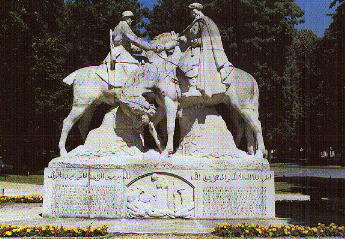![]() CHARLES FAIR
CHARLES FAIR
![]()
This beautiful day was perfect for visiting two attractive towns north of Paris - Chantilly and Senlis - both of which are featured in the Michelin Guide "The Marne 1914."
Chantilly was occupied by the German Army for several days from 3rd. September, 1914. However, the town is more famous for its late 19th century chateau and gardens and the immense stables. These sights are well worth a visit in their own right. They give the town an air of unreality that is matched by few other places that I have visited in France.
Perhaps appropriately, the town was the location of Grand Quartier General, the HQ of the French Army from 1914-16. Marshal Joffre's house in rue de la Liberation is unchanged, and is now an old people's home. A plaque on the wall records his residence from late November 1914 to 26 December 1916. A Statue of Marshal Joffre is nearby in the Avenue de la Gare.
Senlis became briefly famous in September 1914 as part of this pretty town was burnt by the German Army and some of the civilians were shot. "The Marne 1914" describes these events in detail. However it should be remembered that this book was partly written during the war and was published in 1919, so I do not know the extent to which it reflects wartime propaganda. A plaque inside the gothic Cathedrale de Notre Dame summarises the town's role in the war.
The railway station bears a plaque saying that the present building was built in 1922 on the site of the original that had been burnt by the Germans. Opposite the station is a fascinating Monument aux Morts. This has an inscription which records that Senlis marked the furthest point of the German advance on 2 September 1914. Sadly, it also lists those civilians who were shot by the German Army, including the Mayor, M. Odent and a cafe owner, M. Simon. Their stories are told in the Michelin Guide. The memorial also records that Marshal Foch had his headquarters in the town just before the Armistice.
 |
Nearby is the Memorial to Franco-Moroccan Friendship which commemorates the Moroccan units that served in the French army during the war. The work of the sculptor Paul Landowski, it depicts two cavalrymen, one Moroccan and one French, shaking hands. It was originally unveiled by Marshal Lyautey in Casablanca in 1924 and was reerected in Senlis 1965 when it came under threat of demolition. Opposite the cathedral is the small Museum of the Spahis, a Moroccan cavalry unit that was garrisoned in the town from the late 1920s to the early 1960s. |
![]()
 Copyright © Charles Fair, May,
1997.
Copyright © Charles Fair, May,
1997.
Return to the Charles Fair Battlefield Guide START page
Return to the Hellfire Corner Contents Section
|